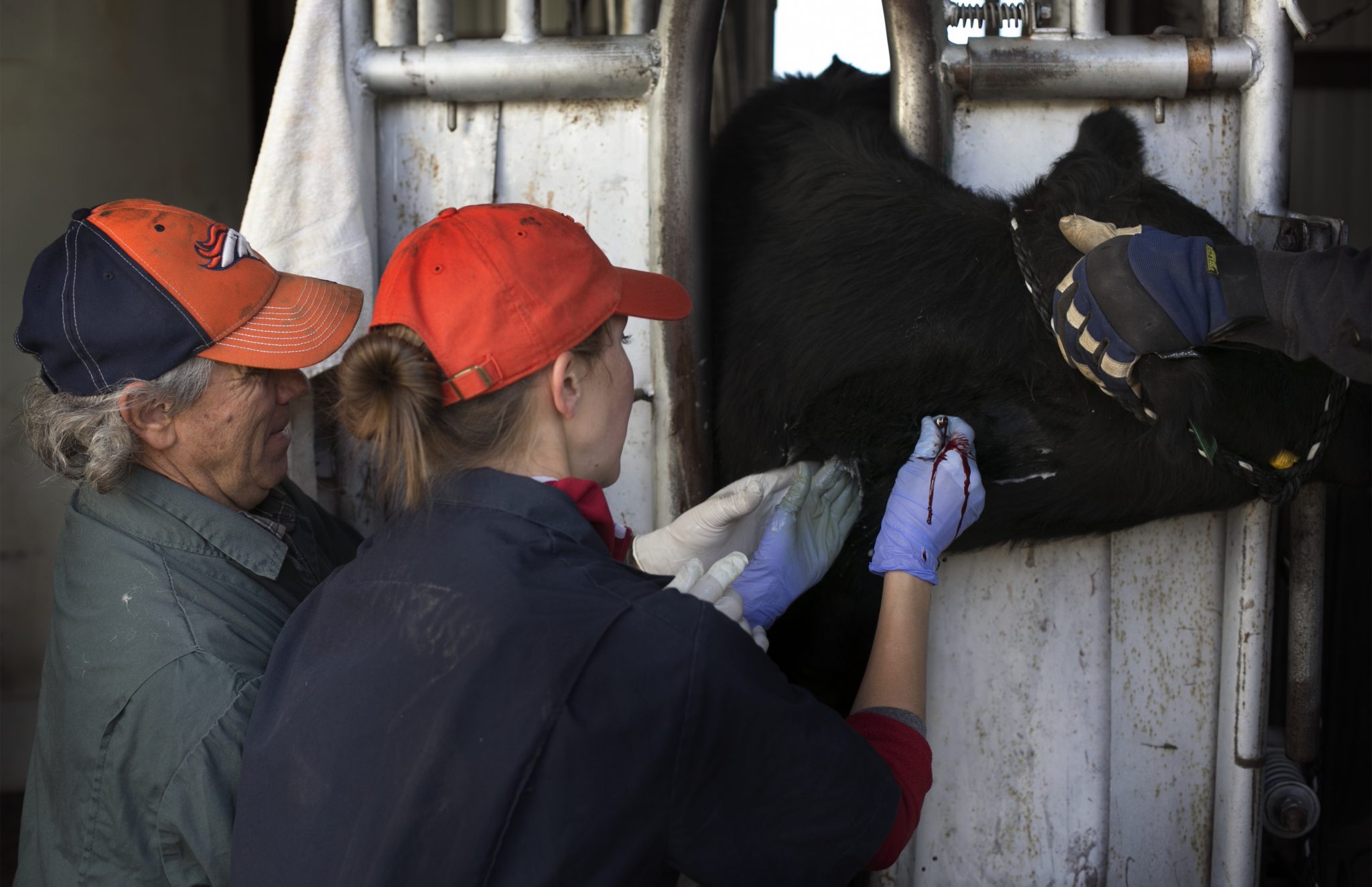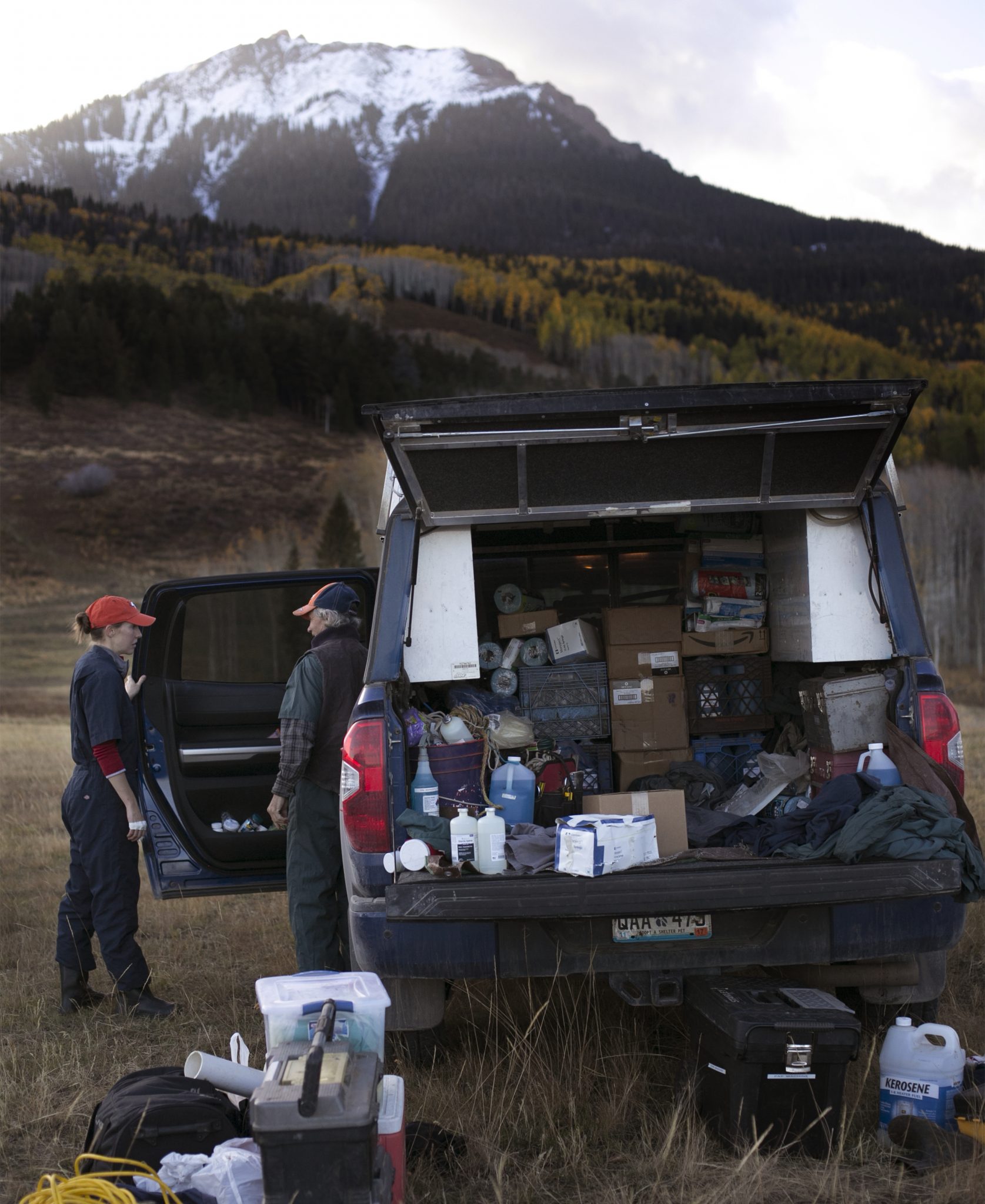By Coleman Cornelius | Photography by Alec Jacobson
Dawn revealed the fall splendor off Last Dollar Road outside Ridgway in October. The Sneffels Range pierced the morning sky with jagged beauty, its peaks brushed with snow. The season’s last golden leaves clung to aspen trees. And a ranch hand on horseback gathered a group of Angus cows and calves from the high country, slowly pushing the herd through a sweeping mountain meadow and into a series of tidy corrals. The scene was so iconic, so perfectly Colorado, that it would have been easy to overlook a potential problem – a potentially lethal problem – in the hearts of cattle here. The setting at 9,370 feet above sea level offered a clue, as did the veterinarian unpacking equipment nearby.
“This is a very important day. This is when I find out what I can sell and what I can sell it for. A lot gets decided today,” rancher Mike Ripp said, as he leaned on a corral fence observing nearly 40 mother cows and their 9-month-old calves. The forecast he sought would come from medical insights into the heart health of his cattle.
Dr. Tim Holt, the veterinarian delivering those critical insights, was setting up inside a shed: needles, syringes, catheters, disinfectants, pressure transducer, medical monitor. Holt, an associate professor of livestock medicine at Colorado State University, is the world’s leading expert on a form of cardiopulmonary disease that afflicts cattle at high altitudes. He spends 11 months a year touring the West, with stops at 150 ranches in Colorado, Wyoming, Montana, and Idaho, to test cattle for indications of disease. Through the years, he has pierced the jugular veins of more than 360,000 cattle to probe arteries coursing from their hearts into the tiny arterioles of their lungs.
Unlikely Expert
Holt doesn’t at first seem like an internationally respected heart and lung doctor, with his well-worn coveralls, stained Denver Broncos cap, tattoos of pet basset hounds, and stream of side-splitting stories about earlier days as a country veterinarian.
But he is deadly serious about bovine high-mountain disease. It is a fatal disease caused by pulmonary arterial hypertension, or dangerously high blood pressure in vessels that run from the right side of the heart into the lungs. Pulmonary hypertension triggers a cascade of health effects, resulting in congestive heart failure. The condition is seen in people, too, and it has the same health consequences if untreated. But in cattle, pulmonary hypertension is most often sparked by lower oxygen levels found at elevations above 5,000 feet. Without breeding programs designed to avoid it, high-mountain disease may strike 5 percent to 20 percent of cattle raised in high-country settings, Holt said, and there is little way to treat animals once disease sets in. The problem can occur at much higher rates – and at much lower elevations – in susceptible cattle.
During end stages of disease, body fluid pools and causes swelling in the lower chest cavity, or brisket, of sick cattle, giving the illness its common name, “brisket disease.” As tissues lose fluid, dying animals become thirsty and often are found standing near water tanks, ponds, or streams in the throes of irreversible heart failure. “It’s a terrible disease,” Holt said.
To understand the significance of high-mountain disease in Colorado, consider the state’s mean elevation: 6,800 feet. That’s the highest average among the 50 states, and it puts cattle raised virtually anywhere in Colorado, especially in mountainous areas, at potential risk for developing cardiopulmonary disease. Yet other state attributes, such as a beneficial climate and prevalence of grazing lands, make Colorado an ideal setting for cattle production. In fact, the cattle sector generates nearly $3.5 billion in cash receipts each year in Colorado, making it by far the most important sector in the agricultural industry, a foundational part of the state economy.
So pinpointing a proclivity to high-mountain disease is a top priority among cattle ranchers in Colorado and other Western states. That’s where Holt comes in. His expertise in high-mountain disease makes him a frequent guest speaker at beef industry meetings. In June 2018, he received the prestigious Pioneer Award from the national Beef Improvement Federation for “immeasurable contributions to our understanding of bovine pulmonary hypertension.”

The Gold Standard
Holt is widely known for perfecting the pulmonary arterial pressure test, known as the PAP test, into the gold standard for predicting high-mountain disease in cattle. “This is a human procedure. We just stole it,” he said. “Even in human medicine, this is the test of choice for diagnosing pulmonary hypertension and its prognosis.” With the test, Holt can decipher workings of the telltale heart. He does that work, in mud, blood, and manure, for more than 8,000 bovine patients per year.
Over the course of 35 years, Holt and veterinary colleagues have determined how best to administer the PAP test in cattle, how to interpret results, and, most important, how to use test data as a deciding factor in cattle breeding. Susceptibility to high-mountain disease is inherited, so reliable data from PAP testing indicate not only whether an individual animal is likely to develop the disease, but whether the same animal is likely to pass on a predisposition to offspring. Tracking PAP scores through generations, and consistently breeding cows and bulls with advantageous scores, can nearly eliminate high-mountain disease in herds, Holt has found. That’s good for animal health and the economy.
“In this area, it’s incredibly important to know the genetics of your cattle,” said Laurel Sundberg, a CSU veterinary student who accompanied Holt on part of his testing tour. “It’s also a welfare issue. As veterinarians, we’re helping ranchers select cattle that will do well at this altitude.”

Ripp, who grazes cattle in the mountains outside Ridgway, has hired Holt for 21 years running to administer the PAP test in registered Angus bull calves that will be sold as herd sires for other ranches. Young bulls with impressive scores – indicating less likelihood for acquiring and passing on disease – have an “altitude advantage” and sell for up to $2,000 more, or $5,000 total, compared to those with average scores, he said. “The ranchers who run cattle at high altitudes will pay more for the reliability of bulls tested up here,” said Ripp, who is president of the Western Colorado Angus Association.
Eager to hear test results in October, Ripp manned the head catch of a squeeze chute as 38 bulls passed through for PAP evaluation. His ranching partners – wife, Vicki, and mother-in-law, Thelma Starner – sat in camp chairs close by, logging scores that would guide decision-making about how to pair cattle during the next breeding cycle. The scores would also help dictate which bulls to market as herd sires and how to price them. Bulls that didn’t make the cut would get the cut: They would be castrated and sold as lower-value steers to be finished for market, ultimately routed to the meat counter.

Holt, with help from Sundberg and longtime veterinary technician Lisa Herrick, scrubbed the neck of a patient with chlorhexidine and, with gloved fingers, palpated for the jugular vein. Then, with one lightning-fast stroke, Holt pierced the animal’s jugular with a 3.5-inch-long, large-bore needle, producing a single spurt of blood. The bull didn’t flinch. Holt then threaded a sterile catheter through the needle and into the animal’s jugular vein, on to the right atrium of the heart, the right ventricle of the heart, and finally into the pulmonary artery for the decisive reading. He used nearly 3 feet of thin, flexible catheter tubing to reach the target.
A pressure transducer, a key instrument in the testing system, detected fluid pressure exerted on the catheter and converted that pressure into an electrical signal, producing wave forms and blood-pressure scores on a medical monitor. Holt watched the monitor intently as he nudged the catheter forward. “Every part of the blood system has a distinct wave form,” allowing him to follow the catheter’s progress to the heart, he explained. Holt and the ranchers hovering nearby were keen to identify bulls with PAP scores less than 41 mmHg, indicating genetic resistance to high-mountain disease.
The Elite
“We’re looking for the elite,” Holt said. He soon found them: Young bulls with PAP scores of 37 mmHg, 38 mmHg, 36 mmHg – exceptional test results above 9,000 feet. The ranchers responded gleefully as more than half their bulls scored in the ideal range. “I feel really good about these scores,” Ripp said. “If cattle test well here, they can go anywhere. The fact that I PAP test at this altitude is a big marketing hook for me.”
Drs. George Glover and Isaac Newton, seminal figures in CSU’s veterinary program, first described high-mountain disease in 1915. Nearly seven decades later, Holt, who grew up in Denver, was introduced to the disease while studying agricultural biology as an undergraduate at Fort Lewis College in Durango. He got a job in 1980 helping with research into why bulls were routinely getting sick after transport from lower elevations to an evaluation center near his college campus. It sat at 8,091 feet above sea level. “The first cow I touched was during PAP testing. Then I was addicted,” Holt said. He began to wonder whether the test protocol could be improved and whether data produced could be tracked over time to reduce incidence of disease. “I wanted to give producers an option to select cattle genetically resistant to the effects of altitude,” Holt said. He worked with two ranches in southwestern Colorado to prove his concept. Holt, who earned his veterinary degree at CSU, practiced for nearly two decades in Gunnison, then joined the CSU veterinary faculty and continues to help ranchers apply PAP scores to management decisions.
The Ripps’ ranch above Dallas Divide is the highest point Holt annually conducts PAP tests, and he was pleased with data collected. Yet he had another objective during the trip – teaching. “Mind if I give it a stab?” Sundberg asked after observing Holt’s smooth technique. Like her mentor, she wore a Denver Broncos cap, a requirement for students on the PAP tour. Unlike her mentor, uncertainty clouded her face as Sundberg held a fresh, 13-gauge needle – with a circumference somewhere between a piece of spaghetti and a pencil – and contemplated the neck it would enter.

Ripp haltered the patient and pulled the bull’s head to the side to expose the jugular vein. Herrick sprayed on a sterilizing solution, and Holt held Sundberg’s right hand to demonstrate correct position. “You can’t hesitate,” she said, reminding herself. With a quick jab, she hit her mark. “Beautiful. That was gorgeous,” Holt told his student. Holding the needle’s hub, Sundberg advanced a catheter toward the bull’s pulmonary artery. “You’re almost there,” Holt coached, as he watched wave forms on the monitor. “Now back it out a little. There you go. Sweet! That’s a 40.” Sundberg had learned the science of PAP testing, but working alongside Holt gave her another impression. “It’s an art,” she said.
Fellow veterinary student, Rose Digianantonio, who had assisted on an earlier visit to Tie Siding, Wyo., said tagging along with Holt gave her new respect for ranching. “I like getting out here, meeting these people, and seeing how much people care and the work they do to produce their cattle. It’s been amazing,” Digianantonio said, standing in a muddy corral as a blustery fall snowstorm approached. “Dr. Holt is an amazing person to learn from. It’s so cool to be part of something so innovative.”
After repacking equipment at the Ripp ranch, Holt and his two-woman veterinary crew headed north to Montrose, where another 200 bulls awaited testing. They would work until 9 o’clock that night before moving north again.






